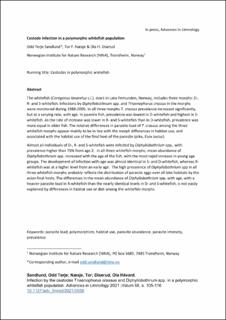| dc.description.abstract | The whitefish (Coregonus lavaretus s.l.) stock in Lake Femunden, Norway, includes three morphs: deepwater spawning (D-), river spawning (R-) and shallow water spawning (S-) whitefish. Infections by Diphyllobothrium spp. and Triaenophorus crassus in the morphs were monitored between 1988–2005. The mean number of T. crassus recorded per infected fish varied between 1.64 and 1.77 in the three morphs, and was not significantly different. In all three morphs T. crassus prevalence increased significantly with age, but at a varying rate. In juvenile fish (age 2–4), mean prevalence was 3.7% in D-whitefish, 10.7% in R-whitefish and 23.7% in S-whitefish. As the rate of increase was lower in Rand S-whitefish than in D-whitefish, prevalence was more similar in older fish. The relative differences in prevalence of T. crassus among the three whitefish morphs appear mainly to be in accordance with the morph differences in habitat use, and associated with the habitat use of the final host of the parasite, the northern pike (Esox lucius). Almost all individuals of D-, R- and S-whitefish were infected by Diphyllobothrium spp., with prevalence higher than 75% from age 2. The mean abundance of Diphyllobothrium spp. increased with age in all three whitefish morphs, but with the most rapid increase in young age groups. The development of infection with age was almost identical in S- and D-whitefish, whereas R-whitefish was at a higher level from an early age. The high prevalence of Diphyllobothrium spp. in all three whitefish morphs probably reflects the distribution of parasite eggs, potentially over all lake habitats by the avian final hosts. The mean abundance of Diphyllobothrium spp. was nearly identical in D- and S-whitefish, but significantly higher in R-whitefish. This is not easily explained by differences in habitat use or diet among the whitefish morphs. parasite infection, polymorphism, habitat use, parasite abundance, parasite intensity, prevalence | en_US |
